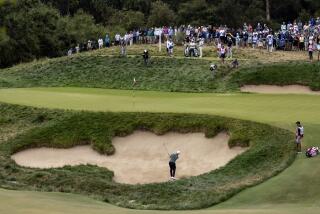Hang On, Everyone, This Will Be a Bumpy Ride
- Share via
SANDWICH, England — A couple of miles from here, there is a road sign that lists the mileage to two cities -- Ham and Sandwich.
While that may seem sort of odd, you ought to see Royal St. George’s golf course.
Players here for the 132nd British Open have used nearly as many words to describe the course as the number of clubs in their bags.
So far, the leaders in the clubhouse are these: quirky, funny, crazy, goofy and fluky.
Throw in Bashful and Doc and you’ve got the Seven Dwarfs.
Instead, you’ve got the fairways at Royal St. George’s.
To say the least, they are different. They’re certainly not anything like the fairways on the PGA Tour -- so flat, so soft, so green, like dollar bills laid out on a bed.
Royal St. George’s has been around since 1874, which means that players have been trying to figure out the fairways for parts of three centuries.
Let’s get right to it. What makes the fairways here so unusual is that they’re so not level. It’s not that they’re tilted one way or the other, it’s that the fairways are chock full of mounds and little hills.
Sometimes the humps are in the most unexpected places, such as directly in the middle of the fairway. This does funny things to a perfectly struck golf ball.
Say a player stripes his drive down the middle. He is feeling mighty good. The ball doinks off a mound and shoots 15 feet to the right, coming to rest in the rough. He feels like flinging his club into Pegwell Bay.
Now, is this fair? Of course not, but players have a way of dealing with bad luck.
Most players believe it all evens out. They stare at their feet and they say that there are going to be a couple of times when they hit a ball off-line and it bounces off a mound and scoots the right direction, closer to the hole.
The reason players say this kind of stuff is because they would go crazy if they didn’t think it could happen that way. If the only bounce possible was a bad bounce, the players would be even worse adjusted than they already are.
Greg Norman won the British Open at Royal St. George’s in 1993 and even shot 64 on the last day to do it. He’s also the same guy who calls the course quirky. He compared playing the course to playing snooker.
The first fairway is Norman’s favorite, at least in the quirky department, because it has lumps, hollows, knobs and knolls.
Those are exactly the words he used.
Norman said it’s a tough course to play mentally.
Thank goodness nobody has to do that.
It must be pointed out that lumpy, bumpy, humpy fairways are nothing new to the British Open. They’re available just about every place they play the event because the Open is played on links courses and links courses have lumpy, bumpy, humpy fairways.
Only they’re not usually as lumpy and bumpy and the rest of the things as the fairways at Royal St. George’s.
It’s hard to say which ones are the humpiest and bumpiest, although Tiger Woods says they are the eighth, the ninth, the 17th and the 18th.
He said sure, you can get fluky bounces, but that’s just part of playing this golf course.
That’s true, but so is headache medicine.
The scores may be low if the weather doesn’t get worse, but the unpredictability factor is probably going to be high.
That starts from the first hole, a 442-yard par four. It takes a drive of 252 yards to carry the first three humps. There’s another sinister-looking bump about 100 yards from the green, another big, curving one at the front of the green to the right and a smaller one to the left.
The eighth is a 455-yard par four. It’s 326 yards to the end of the first part of the fairway. Then there’s 69 yards of hay that must be cleared to reach the green. And, as usual, what a green it is. They are going to have to work hard to find four places that are flat enough to stick a hole in there.
The ninth fairway is murder, the 17th fairway is like hiking and the 18th has more ruts than a gravel road after a summer thunderstorm.
It was one Dr. Laidlaw Purves who came across the big sand dunes here in 1886 and saw the potential for a golf course.
And you know the rest of the story. Players have been taking their lumps ever since.
More to Read
Go beyond the scoreboard
Get the latest on L.A.'s teams in the daily Sports Report newsletter.
You may occasionally receive promotional content from the Los Angeles Times.










